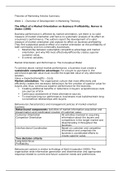Samenvatting
In-depth Summary of all Theories of Marketing Articles (6314M0185Y)
Content: Summary of all mandatory articles in the Theories of Marketing course. Topic 1: Marketing origins Narver&Slater (1990), The effect of a market orientation on business profitability, journal of marketing, October 1990 Slater and Narver (1998) Customer-led and market-oriented, let�...
[Meer zien]




